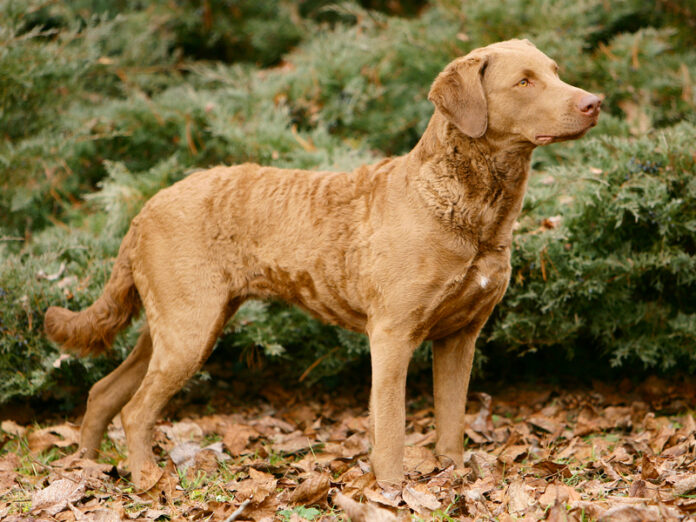Last Updated on August 17, 2023 by Fumipets
Chesapeake Bay Retriever: A Water-loving Working Companion
The Chesapeake Bay Retriever, often referred to as the “Chessie,” is a remarkable breed with a deep-rooted history as a versatile and skilled working dog. With its strong build and distinctive coat, this breed is renowned for its proficiency in water retrieval and unwavering loyalty to its human companions.
In this glimpse into the world of the Chesapeake Bay Retriever, we’ll uncover its unique traits, capabilities, and address some common questions enthusiasts may have about this remarkable canine.
Chesapeake Bay Retriever
The Chesapeake Bay retriever may essentially be any kind of dog. Help you find ducks to hunt? Yup. Best in Show winner? Sure. hang around at your house with the kids and you? Also, that.
This American-bred dog, the only retriever with American roots, is very adaptable. Chesapeake Bay retrievers can swim through the frigid waters of their namesake thanks to their double-coated, oily hair, so they won’t have any trouble swimming in your neighborhood pond (even at temps that the polar bear plungers would find uncomfortable).
According to Heidi Henningson, head of the American Chesapeake Club’s rescue committee, “They’re the definition of the water dog.” When other retrievers will not, they will into the chilly water.
Their renowned water-dog reputation and their skill in duck hunting go hand in hand. Even more, retrievers are capable of working as search-and-rescue and drug-sniffing dogs.
This semi-rare retriever enjoys working and gaining fitness since they are intelligent and cunning. Your Chesapeake Bay retriever can be the ideal pet for you if you promise to love and care for him.
Appearance
Shades of brown, sedge (a reddish brown that you may see on an Irish setter), and dead grass (a softer, yellowy brown that looks like, well, dead grass) are the only colors available for Chesapeake Bay retrievers. According to the breed standard, certain Chessies may also have white markings on their bellies, toes, and chests. Despite the fact that the two breeds are often confused, Chessies are not chocolate Labrador retrievers.
Chesapeake Bay retrievers are known for having wavy hair on their necks, shoulders, and backs. A thick undercoat and a thinner top coat make up the retrievers’ hair. A natural oil that resists water and keeps the dogs warm is also included in the hair. According to Henningson, they don’t shed nearly as much as Labs (or many other dogs, for that matter), so you may not be able to feel it to the touch.
These dogs are of a size that is comparable to Labs. Chessies are typically between 21 and 24 inches tall for females and 23 to 26 inches for males. They are also quite durable: Girls average 55 to 70 pounds, while males range from 65 to 80 pounds.
According to the breed standard, Chessies’ eyes are typically yellow or amber in color.

Temperament
Your Chessie’s personality will rely on how you raise him, as it does with other dogs, according to Henningson. To ensure that your Chesapeake Bay retriever puppy understands the home rules, you should socialize them with other pups and teach them through positive reinforcement.
Henningson claims that while these working dogs are excellent in obedience and agility contests, hunting, show, and other functional roles, they make ideal, devoted family dogs at home. She continues by saying that depending on their upbringing, individuals might also develop a strong devotion to one person.
On the other hand, they tend to be less approachable toward strangers. (You won’t likely have one suddenly rush up and kiss your face.) Additionally, Chesapeake Bay retrievers are typically silent, only barking when required (such as in response to a door knock or doorbell ring).
These are intelligent, energetic dogs who must be kept occupied, whether it is via hunting, drug sniffing, or search-and-rescue operations. Without a little structure, it’s possible to lose sandwiches off coffee tables or have a dog who can open his kennel from the inside even at home. Ask Henningson, please.
They are in some ways precocious, she claims. “They can get into trouble by simply becoming bored at home,” said the expert.
Henningson’s favorite characteristic of Chesapeake Bay retrievers is their “ability to do anything,” she adds, despite the fact that their intellect may often make them a bit too smart for their own good.
Living Needs
Although Chesapeake Bay retrievers may live in apartments, a fenced-in yard where they can run about and play fetch will make them happy. Henningson advises walking your retriever at least twice daily and maybe more if you live in an apartment.
Your dog will get along well with both adults and children if you socialize him well and enroll him in puppy kindergarten. Henningson herself has three Chesapeake Bay retrievers, and Chessies get along well with other dogs and cats in certain cases. (One of her dogs would even snooze in his doghouse next to a stray cat.)
Do you have access to a water feature, such as a pond? It will be a hit with your Chessie. Enjoy hiking? Perfect, your new trekking companion has arrived. They’ll adore partaking in your energetic way of living.
But according to Henningson, Chesapeake Bay retrievers require your affection and care the most. Take notice, first-time dog owners: You must dedicate time to teaching your Chesapeake Bay retriever using positive reinforcement, as well as time for playtime and exercise. Don’t adopt a dog if you’re not ready to make the commitment, she advises.
Care
Any dog needs labor to raise and care for them, but the good news about Chessies is that: There is not much grooming required. Henningson advises that other than when he sheds in the spring and autumn, you won’t need to spend a lot of time grooming your Chesapeake Bay retriever.
If your dog stinks or if he went outdoors and into anything, you may want to give him a wash every now and then. You should establish a schedule for cleaning your retriever’s teeth and cutting his nails, just as you would with any other dog. According to Henningson, the majority of these retrievers won’t need special dog food.

Health
Chesapeake Bay retrievers are generally healthy dogs, according to Deb Eldredge, DVM, a Daily Paws contributor.
Chessies move and run a lot, so Eldredge advises having your retriever checked for hip and elbow issues, like hip dysplasia. Additionally, you should get annual eye examinations. The American Chesapeake Club also suggests having regular cardiac exams.
Degenerative myelopathy, a neurological condition that might potentially render your dog unable to walk, has been discovered to afflict certain Chessies more recently. A DNA test may be requested by owners to perhaps determine whether or not their dog is in danger, but Eldredge warns that it may not be definitive.
When buying a Chessie puppy, Eldredge advises searching for parents that have undergone the examinations advised by the Chessie [Canine Health Information Center] program. “While it’s not a guarantee, having healthy test results significantly reduces the likelihood of ever experiencing such issues. Before putting their pups, many breeders will have the initial eye check performed on them.
Despite the fact that eating is vital, watch your intake. Eldredge believes overweight canines may have joint problems. The quantity and frequency of your dog’s meals might be suggested by a veterinarian.
The typical lifetime of a Chesapeake Bay retriever is 10 years old, according to Henningson. Even some make it to ages 13 to 15.
History
Numerous dogs, including Labrador retrievers, Newfoundlands, and Belgian Malinois, are named after countries or regions outside of the United States. However, the Chesapeake Bay, the greatest estuary in the country and a source of delectable seafood, is the name of the breed and a famous American landmark.
Additional information about the bay: The majority of it is frigid, shallow, and a sanctuary for ducks and geese. The Chesapeake Bay retriever, probably a cross between a Newfoundland, an Irish water spaniel, and other hounds, was developed to be the ideal canine for plunging into the chilly water to recover lost ducks.
The dogs’ hair, a double layer of insulation and water-resistant oil, enables them to work even when there is ice on the water. Some Chessies are said to be capable of retrieving 300 ducks in a single day.
Specifically, two dogs called Sailor and Canton, which a man named George Law donated to two individuals he met on the bay in 1807, are credited with starting the breed. He dubbed them Newfoundlands, although they were the earliest progenitors of today’s Chessies based on their color, shorter coats, and swimming prowess.
The breed was recognized by the American Kennel Club in 1878
Q&A: Chesapeake Bay Retriever
What sets the Chesapeake Bay Retriever apart from other retriever breeds?
The Chesapeake Bay Retriever stands out due to its distinct double coat, which provides excellent insulation and protection in the water. Its webbed feet and powerful build make it a natural swimmer and skilled retriever.
What was the Chesapeake Bay Retriever originally bred for?
The breed was developed in the Chesapeake Bay region of the United States to excel at retrieving waterfowl from frigid waters. Its ability to work in harsh conditions, including icy water, showcases its endurance and determination.
What is the temperament of the Chesapeake Bay Retriever?
Chesapeake Bay Retrievers are known for their loyalty, intelligence, and protective nature. They are devoted to their families and can be reserved with strangers. They thrive on training and enjoy having a job to do, making them excellent companions for active individuals or families.
Are Chesapeake Bay Retrievers suitable for families with children?
Yes, Chesapeake Bay Retrievers can be wonderful family companions. They are affectionate with their family members, including children, and can form strong bonds. However, early socialization and training are essential to ensure a harmonious relationship between the dog and children.
What kind of training and exercise do Chesapeake Bay Retrievers require?
Chesapeake Bay Retrievers are intelligent and eager to please, making them receptive to training. They thrive on mental and physical challenges, so engaging activities like obedience training, retrieving games, and agility exercises are beneficial for their well-being.
Do Chesapeake Bay Retrievers get along with other pets?
Chesapeake Bay Retrievers can get along well with other pets if properly socialized from a young age. Their interaction with other animals depends on their individual temperament and early experiences.
Do Chesapeake Bay Retrievers have any specific health considerations?
Like all breeds, Chesapeake Bay Retrievers can be prone to certain health issues, including hip dysplasia, elbow dysplasia, and eye conditions. Regular veterinary care, proper nutrition, and maintaining a healthy weight are important for their overall well-being.
In Conclusion: A Remarkable Working Companion
The Chesapeake Bay Retriever’s history as a skilled working dog, coupled with its loyalty and adaptability, make it a breed that excels in various roles – from a hunting partner to a loving family companion. Its remarkable water abilities and tenacious spirit continue to make the Chesapeake Bay Retriever a beloved choice for individuals and families seeking a loyal and capable canine companion.


















